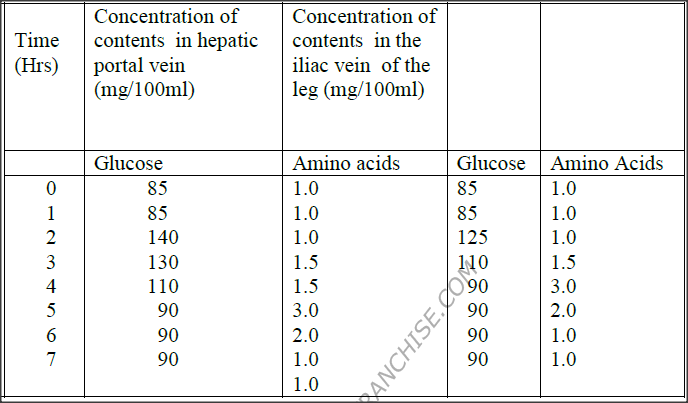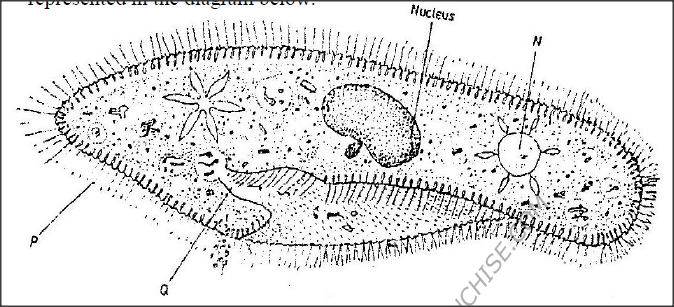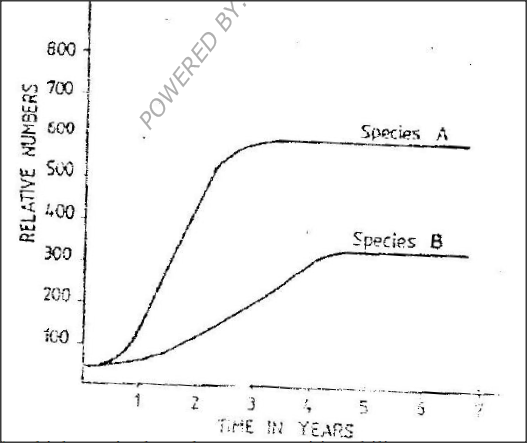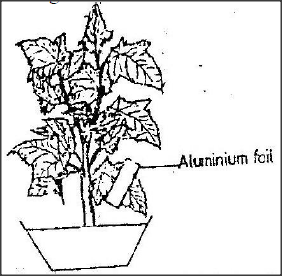|
K.C.S.E Biology Q & A - MODEL 1998PP1QN20
Explain how the mammalian intestines are adapted to perform their function.
answers
The mammalian intestines are relatively long/coiled/folded. This allows food enough (enough) lime/increases surface area for digestion and absorption of products of digestion. The intestinal surface area for absorption. The glands have enzymes which secrete enzymes for digesting e.g. of correct enzyme, maltase, sucrase, lactase, enterokinase and peptidases. Some glands/goblets cells also produce mucus which protects the intestinal wall from being digested, reduce friction. Intestines have opening of ducts which allows bile/pancreatic juice into the lumen. The intestines have circular and longitudinal muscles whose contraction/relaxation/peristalis leads to the mixing of food with acc. At least enzymes/juices facilitating rapid digestion and helps pus food along the gut. Intestines are well supplied with blood vessels to supply oxygen/remove digested food. Presence of lacteal vessels for transport of fats/lipids.
Have thin epithelia to facilitate fast/rapid absorption/diffusion. Allow increase in surface area for absorption only. Cell biology/cytology. Occurrence of cell e.g. mitochondria, ribosome’s, nucleas, cytochromes organelle point to a common ancestry.
0 Comments
K.C.S.E Biology Q & A - MODEL 1998PP1QN19
Discuss the various evidences, which show that evolution has taken place.
answers
Comparative anatomy/taxonomy.
K.C.S.E Biology Q & A - MODEL 1998PP1QN18
A hungry person had a meal, after which the concentration of glucose and amino acids in the blood were determined. This was measured hourly as the blood passed through the hepatic portal vein and the iliac vein in the leg. The results were as shown in the table below.
(a) Using the same axes draw graphs of concentration of glucose in the heptic portal vein and the iliac vein in the leg against time
(b) Account for the concentration of glucose in the hepatic vein from: (i) 0/1 hour (ii) 1-2 hour (iii) 2- 4 hours (iv) 5 – 7 hours (c) Account for the difference in the concentration of glucose in hepatic portal vein and the iliac vein between 2 and 4 hours. (d) Using the data provided in the table explain why the concentration of amino acids in the hepatic portal vein took longer to increase.
answers
(a) If axes reversed allow marks for identification of curves only max 2
Correct scales Correctly leveled axes Curves reject broken lines for curves (b) 0-1 hour. i) Acc constant/low/below normal levels in blood; No/little digested foods/glucose from the intestines/gut/alimentary canal/absorption. ii) 1-2 hours Sharp increase in concentration of glucose in blood; (more) absorption of glucose; after digestion of the meal. iii) 2-4 hours. Glucose concentration declining/decreasing; less glucose being absorbed; (more) glucose being converted to glycogen in the liver/tissue/used for (tissue) respiration. iv) 5-7 hours. Concentration of glucose stabilizes/constant/ this is the normal glucose level concentration in the blood. (c) The concentration of glucose in the iliac vein is lower than in the hepatic portal vein because it hasn’t been stored in the liver to be used respiration. Portal vein because most of it was stored/used up by the liver/other tissues/respiration. (d) Proteins take longer to digest. K.C.S.E Biology Q & A - MODEL 1998PP1QN17
The diagram below represents a nerve cell.
(a) (i) Identify the nerve cell.
(ii) Give a reason your answer in (a) (i) above (b) Name the structure labeled T (c) Using an arrow indicate on the diagram the direction of movement of an impulse in the cell.
answers
(a) (i) Sensory neurone/sensory nerve cell; reject sensory nerve
(ii) Cell body on a branch/ at the side of axon/off the axon/cell body unipolar both axon and dendron are long. (b) T- myelin sheath; Acc Neurilema (c) Direction of impulse from receptor towards cell body. K.C.S.E Biology Q & A - MODEL 1998PP1QN16
A student placed a drop of pond water in a cavity slide and observed it under the microscope. The student observed many fast moving organisms, one of which is represented in the diagram below.
(a) (i) Name the phylum to which the organism belongs
(ii) Give a reason for your answer in (a) (i) above (b) Name the structures labeled N, P and Q. (c) State two observable features that enable the organism to move fast.
answers
(a) (i) Protozoa
(ii) Unicellular/ single celled (b) N- Contractile vacuole P – Cilia, Acc cilium Q – Gullet/cytopharynx (c) Cilia Streamlined body. K.C.S.E Biology Q & A - MODEL 1998PP1QN15
The herbivorous mammalian species were introduced into an ecosystem at the same time and in equal numbers. The graph below represents their populations during the first seven years. Study the graph and answer the questions that follow..
(a) (i) Which species has a better competitive ability?
(ii) Give reason for your answer (b) Account for the shape of the curve species A between (i) One year and three years (ii) Three years and seven years (c) A natural predator for species A was introduced into the ecosystem. With a reason state how the population of each species would be affected.
answers
(a) (i) Species A;
(ii) The rate of multiplication/ growth in A is faster than of species B (b) (i) One year and three years 1-3 years shortage of resources more suitable environmental Conditions/ such as food space e.t.c resource were not limiting hence the population increased exponentially rapidly; acc correctly named resource e.g food space. (iii) Three years and seven years 3-7 years shortage of resources/ limiting/ birth rate equals death rate; hence the population had become stagnant/ constant; acc; Environmental resistance has set in rej. Incorrect resources e.g PT and T. (c) Species A would decrease (because of there is less competition with species A/ More resources available. K.C.S.E Biology Q & A - MODEL 1998PP1QN14
In an experiment to investigate a factor affecting photosynthesis, a leaf of a potted plant which had been kept in the dark overnight was covered with aluminum foil as shown in the diagram below
The set up was kept in sunlight for three hours after which a food test was carried out on the leaf.
(a) Which factor was being investigated in the experiment? (b) What food test was carried out? (c) (i) State the results of the food test (ii) Account for the results in c (i) above (d) Why was it necessary to keep the plant in darkness; before the experiment?
ANSWERS
(a) Light; Rej: light intensity
(b) Test for starch (c) (i) The covered part of the leaf remain brown/yellow/ retain color of iodine, and the uncovered parts turned blue/ black; rej blue alone black alone. (ii) Starch was formed in the covered part of the leaf (because of the presence); while starch was not formed in the covered part of the leaf ( because of lack light) (d) To destarch the leaf; K.C.S.E Biology Q & A - MODEL 1998PP1QN13
(a) List four differences between meiosis and mitosis
(b) Which sex chromosomes are found in human? Sperm cell? Ova? K.C.S.E Biology Q & A - MODEL 1998PP1QN12
In a family with four children, three were found to have normal skin pigmentation while one was an albino. Using letter A to represent gene for normal skin pigmentation and a to represent the gene for albinism,
(a) What are the genotypes of the parents? (b) Work out the genotype of (i) Normal pigmentation (ii) The albino child Genotype of normal pigmented children (c) What is the probability that the fifth child will be an albino?
K.C.S.E Biology Q & A - MODEL 1998PP1QN11
State two ways by which the human immuno deficiency (H.I.V) is transmitted other than through sexual intercourse?
ANSWERS
K.C.S.E Biology Q & A - MODEL 1998PP1QN10
Give two reasons why primary productivity in an aquatic ecosystem decreases with depth.
ANSWERS
K.C.S.E Biology Q & A - MODEL 1998PP1QN09
What makes young herbaceous plant remain upright?
ANSWERS
K.C.S.E Biology Q & A - MODEL 1998PP1QN08
A flower was found to have the following characteristics:
Inconspicuous petals Long feathery stigma Small, light pollen grains (a) What is the likely agent of pollination of the flower (b) What is the significance of the long feathery stigma in the flower?
ANSWERS
(a) wind
(b) To enable it trap pollen grains in the air; reject catch/ attach for trap K.C.S.E Biology Q & A - MODEL 1998PP1QN07
The diagram below represents a mammalian bone
(a) Name the bone
(b) Name the type of the joint formed by the bone at its anterior end with the adjacent bone
ANSWERS
(a) Femur
(b) Ball and socket K.C.S.E Biology Q & A - MODEL 1998PP1QN06
In an experiment it was found that when maggots are exposed to light they move to dark areas.
(a) Name the type of response exhibited by the maggots (b) Name the advantages of the response to the maggots
ANSWERS
(a) Phototais
(b) To avoid desiccation/ drying/ dehydration Escape from predators; What is the relationship between leguminous plants and bacteria found in their root modules?15/6/2020
K.C.S.E Biology Q & A - MODEL 1998PP1QN05
What is the relationship between leguminous plants and bacteria found in their root modules?
ANSWERS
K.C.S.E Biology Q & A - MODEL 1998PP1QN04
Why are gills in fish highly vascularized?
ANSWERS
K.C.S.E Biology Q & A - MODEL 1998PP1QN03
Which organelle would be abundant in:
ANSWERS
Skeletal muscle cell
K.C.S.E Biology Q & A - MODEL 1998PP1QN02
State one effect of magnesium deficiency in green plants
ANSWERS
K.C.S.E Biology Q & A - MODEL 1998PP1QN01
Why are people with blood group O universal donors?
ANSWERS
|
Archives
December 2024
Categories
All
TOPICSFORM 1
Form 2
Form 3
Form 4
|
Can't find what you are looking for? Don't worry, Use the Search Box Below.
|
Primary Resources
College Resources
|
Secondary Resources
|
Contact Us
Manyam Franchise
P.O Box 1189 - 40200 Kisii Tel: 0728 450 424 Tel: 0738 619 279 E-mail - sales@manyamfranchise.com |
















 RSS Feed
RSS Feed

